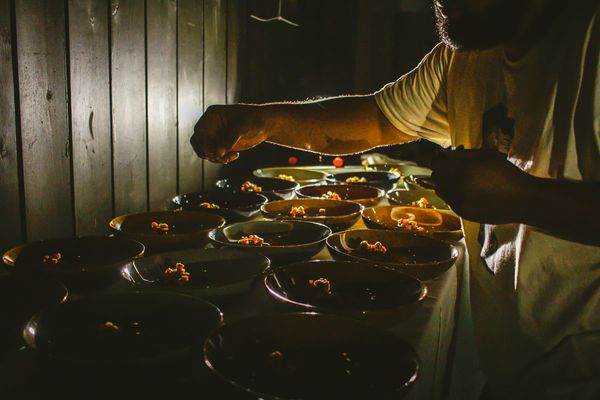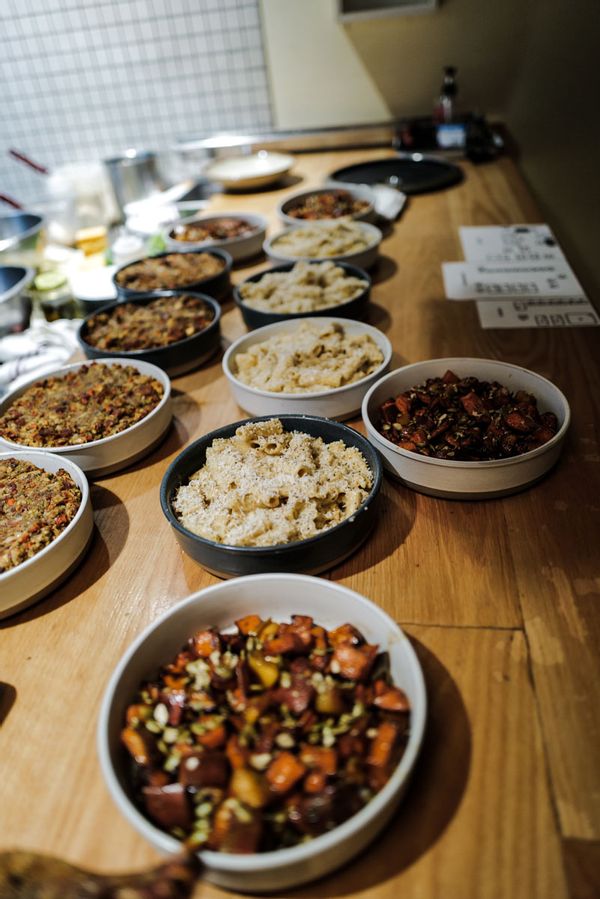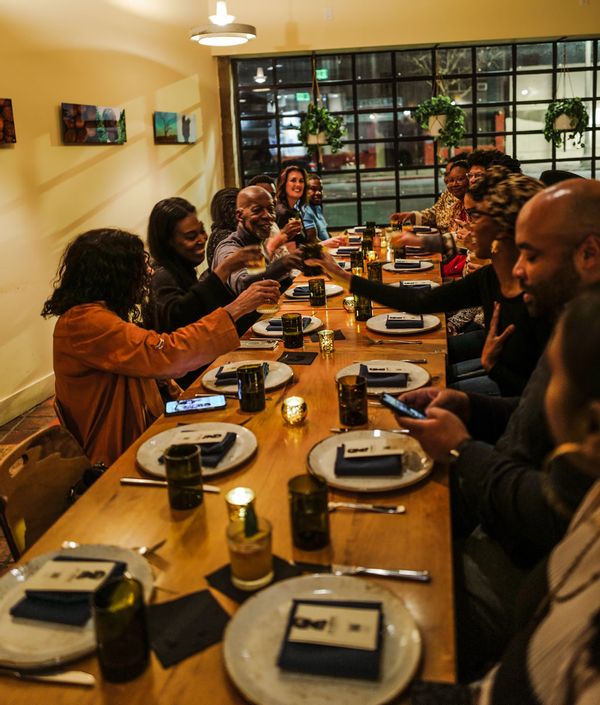
Supper clubs are amazing. Supper clubs that honor, prioritize and amplify history, culture and ancestral recipes are even better.
Sometimes, though, they can be seen as elite or upper crust — and not particularly accessible.
That isn’t the case for Black Pot Supper Club. For Chef Martin Draluck, celebrating and sharing the stories (and food) of enslaved chefs is a central point of his career. With Black Pot Supper Club, he is able to concentrate his culinary prowess and his deep knowledge and passion for those that came before him into a singular, inspired organization.
Black Pot Supper Club is an eight-course, wood-fired tasting menu that lasts three hours and serves 20 people at a communal table. There are Black bartenders, discussions of the "black pot" itself, highlights of enslaved chefs, superb food and a tour of the kitchen. "For these dinners, we build a makeshift wood-fired hearth in a space behind the restaurant’s patio to recreate how chefs like Hemings and Hercules would have been preparing food, allowing you to smell the smoke and feel the heat of the fire, an integral part of the enslaved chef experience," Draluck said. The experience also highlights "small, Black-owned vineyards and their varieties" with their wine pairings.
“With every course, we share stories about the lives of James Hemings and Hercules Posey or about some of our other earliest culinary influencers like Malinda Russell and Abby Fisher,” Draluck shared, referencing some of the people the Black Pot Supper Club often honors.

What about the food, you might be asking?
“The seasonal menu has featured things throughout our time like black eyed pea cakes, yam tostones and Philadelphia pepper pot," Drackluck said. "These are all small-bite courses leading to a family style main course that could feature anything from suckling pig, to fried fish or wood roasted capon (castrated chicken) and all served with an assortment of accouterments meant to mimic the large meals that were consumed during the colonial era that could often feature up to thirty different dishes per course, for tables consisting of up to 60 people at a time.”
The name of the club hails from the deep importance of the cast iron pot — the historic, iconic and amazingly functional vessel which, as Draluck put it, "will last you multiple lifetimes (if you take care of them)." He shared that many cast iron black pots are often deemed heirlooms that are "passed along with the recipes that nourished our ancestors."
Draluck notes that he was most inspired by his maternal grandmother, "a New York raised Jew and passionate Civil Rights activist and history buff," along with her husband and Draluck's grandfather, who is a "Black, Texan-born, former cotton-picking, Marine veteran-turned-BBQ pitmaster." He was also, of course, inspired by his mother.
Draluck also highlights Brian Dusmoor, his friend and culinary mentor, with whom he worked at Hatchet Hall. The pair were curious about the tenets of what defines "American food" and what that means at its core. They formed Fuss & Feathers, a multi-course tasting menu, to explore those questions. Eventually, Draluck ended up focusing on the work of Hercules Posey and James Hemings — arguably America's first "celebrity chefs," who were also the enslaved property of two United States presidents — as a spin-off of Fuss & Feathers. That eventually led to the Hemings & Hercules series that currently defines Black Pot Supper Club.
"Hemings and Hercules were enslaved chefs and the property of Presidents Thomas Jefferson and George Washington, respectively and in many ways can be considered the country’s first celebrity chefs due in part to the famous men they worked for, but also for their prowess in the kitchen," Draluck said.
Draluck's knowledge of these men and their deep influence is both impressive and inspiring, as he detailed their shopping habits, their dressing proclivities, their amazing repertoires and resumes, the places in which they cooked and the people whom they cooked for, including President Thomas Jefferson.
At the time, Jefferson "took a 19-year-old James [Hemings] with him with the specific purpose of having him trained in classic French haute cuisine. James would train with the top chefs, pastry chefs and caterers in the country, culminating in him running culinary programs in the country, as well as cooking for the distinguished guests visiting Jefferson at his embassy home"

After the initial supper club dinners, COVID did a number on Draluck’s growing supper club until "High on the Hog" was released on Netflix. The series featured their Hemmings & Hercules dinner. Afterwards, Draluck spoke with John Cleveland — chef and owner of Post & Beam — about utilizing his space to continue his important endeavor.
Since then, he has served over 60 dinners, honoring his cultural and culinary ancestors with each dish. "I enjoy looking through the old cookbooks and trying to present old ideas in a new way," Draluck said.
Draluck specifically mentions a particular supper club event held at Dunmere by the Sea.
"The Dunmere itself was built in 1884, sits steps from the beach and is a historically protected site for being featured in the 1964 edition of 'The Green Book' as one of a handful of places suitable for rent to traveling Blacks at the time," Draluck said.
Dr. Jessica Harris — the author of "High on the Hog" — attended the dinner, which was the highlight of the evening for Draluck.

Draluck has two favorite dishes; "The first is our head cheese grilled cheese dish which can best be described as an open faced, ham and cheese sandwich with pickles and dijonaise."
His other favorite? James Heming's snow egg, which he described as "an egg custard, which is one of only about four recipes that exist directly attributed to James. It’s a beautiful light dessert that isn't very common here in the states and is a perfect ending to the eight-course meal."
When the dish is served, "we hand out a two-sided recipe card that has James’ original recipe on one side, as well as the recipe for the dish presented to them that has updated measurements and directions for the modern kitchen,” Draluck shared, noting that it’s a “nice touch to end the evening.”

So, what's next for Draluck and the Black Pot Supper Club?
"The ideal future for the Supper Club has many avenues. I’d love to be able to set up a traveling program where we can share these stories all over the country highlighting some of our most well-respected Black restaurant and event spaces," Draluck said. "I’d love to work with Mount Vernon and or Monticello in some capacity telling the stories of Hercules, James Hemings and Edith Fossett."
Furthermore, Draluck is encouraged and enthused about the idea that he can "give the opportunity or lay a foundation for other people and cultures to share their food history."
"Because," he continued, "The cast iron pot isn't exclusive to just Southern or Black food."
For additional information on Black Pot Supper Club, you can learn more here.







